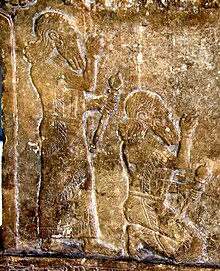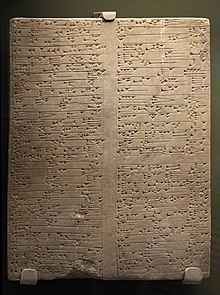Tukulti-Ninurta I
| Tukulti-Ninurta I | |
|---|---|
 Tukulti-Ninurta I depicted both standing and kneeling | |
| King of theMiddle Assyrian Empire | |
| Reign | c.1243–1207 BC[1] |
| Predecessor | Shalmaneser I |
| Successor | Ashur-nadin-apli |
| Issue | Ashur-nadin-apli,Enlil-kudurri-usur |
| Father | Shalmaneser I |
Tukulti-Ninurta I(meaning: "my trust is in [the warrior god]Ninurta";reignedc.1243–1207 BC) was a king ofAssyriaduring theMiddle Assyrian Empire.He is known as the first king to use the title "King of Kings".
Biography
[edit]Tukulti-Ninurta I succeededShalmaneser I,his father, as king and won a major victory against theHittite Empireat theBattle of Nihriyain the first half of his reign, appropriating Hittite territory inAsia Minorand theLevant.Tukulti-Ninurta I retained Assyrian control ofUrartu,and later defeatedKashtiliash IV,theKassiteking ofBabylonia,and captured the rival city ofBabylonto ensure full Assyrian supremacy overMesopotamia.He set himself up as king of Babylon, and took on the ancient title "King of Sumer and Akkad"first used byUr-Nammu.
Tukulti-Ninurta had petitioned the godShamashbefore beginning his counter offensive. Kashtiliash IV was captured, single-handed by Tukulti-Ninurta according to his account, who "trod with my feet upon his lordly neck as though it were a footstool" and deported him ignominiously in chains to Assyria. The victorious Assyrian demolished the walls of Babylon, massacred many of the inhabitants, pillaged and plundered his way across the city to theEsagilatemple, where he made off with thestatue of Marduk.After capturing Babylonia, he invaded theArabian Peninsula,conquering the pre-Arab states ofDilmunandMeluhha.[2]Middle Assyrian texts recovered at ancient Dūr-Katlimmu include a letter from Tukulti-Ninurta to hissukkal rabi'u,or grand vizier,Ashur-iddinadvising him of the approach of his generalShulman-mushabshuescorting the captive Kashtiliash, his wife, and his retinue which incorporated a large number of women, on his way to exile after his defeat. In the process he defeated theElamites,who had themselves coveted Babylon. He also wrote an epic poem documenting his wars against Babylon and Elam. After a Babylonian revolt, he raided and plundered the temples in Babylon, regarded as an act of sacrilege to all Mesopotamians, including Assyrians. As relations with the priesthood inAshurbegan deteriorating, Tukulti-Ninurta built a new capital city;Kar-Tukulti-Ninurta.However, his sons rebelled against him and besieged him in his new city. During the siege, he was murdered. One of them,Ashur-nadin-apli,would succeed him on the throne.
After his death, the Assyrian Empire fell into a brief period of stagnation. TheTukulti-Ninurta Epicdescribes the war between Tukulti-Ninurta I and Kashtiliash IV.[3]

Sources
[edit]- ^Chen, Fei (2020)."Appendix I: A List of Assyrian Kings".Study on the Synchronistic King List from Ashur.Leiden: BRILL.ISBN978-9004430914.
- ^J. M. Munn-Rankin(1975). "Assyrian Military Power, 1300–1200 B.C.", in I. E. S. Edwards (ed.)Cambridge Ancient History,Volume 2, Part 2. Cambridge University Press. pp. 287–288, 298.
- ^The Cambridge Ancient History, I. E. S. Edwards, C. J. Gadd, N. G. L. Hammond, (ed) I. E. S. Edwards, C. J. Gadd, N. G. L. Hammond, Edition 3, revised, Cambridge University Press, 1975,ISBN0-521-08691-4,ISBN978-0-521-08691-2,pg. 284-295
- ^"stela British Museum".The British Museum.
External links
[edit]- Assyrian origins: discoveries at Ashur on the Tigris: antiquities in the Vorderasiatisches Museum, Berlin,an exhibition catalog from The Metropolitan Museum of Art Libraries (fully available online as PDF), which contains material on Tukulti-Ninurta I
